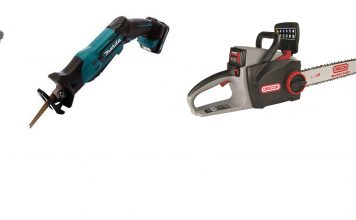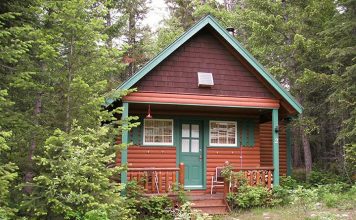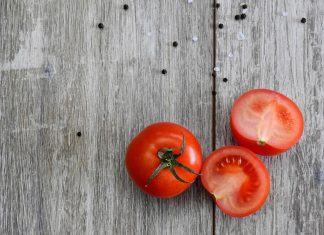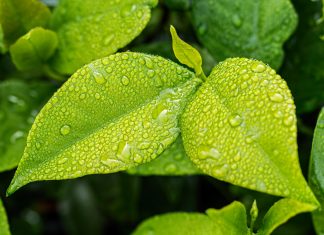| Issue #47 • September/October, 1997 |
Cold stored fruits and vegetables are the next best thing to fresh-picked. Flavor and texture change little and nutritional value remains high. They keep for an amazingly long time. This and the great variety which can be stored make it a technique well worth using. Compared to canning, and even to freezing and drying, little is involved in preparation. This time savings greatly increases the ability to retain valuable produce. By cellaring a large percentage of the harvest, these other more expensive or time consuming methods can be reserved for where each is truly superior for a particular finished productsweet corn frozen on the cob, canned relish, and spicy beef jerky, for example.
Cold storing also lengthens the time span in which foods can be processed for preservation by the other methods. Fruits and vegetables can be moved at leisure from cellar to dryer or canning kettle and to the freezer as this space is vacated. Even if you don’t garden, cold storage can still be used to take advantage of low prices of the autumn cornucopia at local farms. Or better yet, it can provide an opportunity to benefit by participating more extensively in community supported agriculture. And as a bonus, we will see how certain roots (including the noble asparagus) can be tricked into producing delectable sprouts in the dead of winter.
A properly designed and well built root cellar is a marvel of appropriate technology. It soon returns its costand will ultimately return it many times over. However, in the beginning, the problem of the initial investment can be the main drawback to opting for a walk-in unit. Many of us, therefore, have for a time resorted, with varying degrees of success, to the traditional pit/mound storage.
And even after having built a full-size walk-in facility, pits are still often useful in handling the overflow of a bumper crop. When properly done, their contents will not freeze (except in the far north or at great elevation) in even the coldest weather. Over most of the northern United States and southern Canada the temperature inside tends to average between 50 and 55 degrees F., being moderated by the earth below frost line. This, however, is not nearly cold enough to produce the maximum possible storage life for most kinds of produce which do best from just above freezing up to 40 degrees or so. It is also impossible with the old style “squirrel job” to regulate humidity or add warmth to counter extreme cold.
Other disadvantages of the traditional pit are the difficulty of access after a rain and hard freeze or a heavy snowfall, and having to take all of the contents of a particular installation at once due to the near impossibility of safely re-closing the mound under these conditions. All of these limitations are overcome by this new development.

Figure 1. The vertical wooden duct |
Pit storage
The crux of the system is three fold:
1. A vertical wooden duct (Figures 1 and 2) around which the produce is arranged
2. The produce contained in sacks attached at intervals along a rope (Figure 3)
3. A well box (Figure 4) supporting an access hatch several feet above ground level.The central duct provides several key features. It serves variously to:
(a) introduce cold outside air to the bottom of the pit when the temperature must be lowered
(b) allow the installation of a hot or cold object when the temperature must be adjusted
(c) admit a cloth sack containing a moisture absorbing, desiccant material to reduce humidity
(d) channel water to the interior when humidity must be increased, and
(e) to permit the temporary placement of a thermometer and hygrometer to monitor these variables.
The sack and rope arrangement allows easy access to a small amount of produce for consumption, or efficient removal and replacement of the entire contents for inspection. Spacing the bags a sufficient distance apart along the rope permits hauling each without having to disturb the one behind it. A combination of two easily tied and released knots readily fastens sacks to the main line.

Figure 2. Internal cutaway view of well housing over the central duct |
Construction of such a storage involves digging a square hole encircled at ground level by a shallow, gravel filled, drainage trench, installing the lower stage duct assembly, positioning the well box, and banking it with earth (Figure 5). At storage time the produce is lowered into place, the upper stage is positioned, and the space between the top of the produce and the hatch is filled with sacks of insulation fixed to a separate long line system. Except for occasional inspection and monitoring, that’s it.
Perfect control of such an installationas with any root cellaris a little bit science and a whole lot of art. But it’s really not all that complicated or critical. The great advantages of this decentralized storage are that it permits tailoring conditions to perfectly suit a particular kind of fruit or vegetable and provides a built in safety factor against any errors. If detailed records are kept to help in pushing the limits from year to year, it becomes a challenging as well as rewarding hobby.
Managing your storage
You must watch the weather like a hawk, taking advantage of cold nights to lower the temperature prior to storing your produce in the fall. Moisture may occasionally have to be added during dry spells or regularly in very dry climates. This applies to all but a few varieties which require dry conditions. When these are stored, the hole should be lined with plastic sheet if there is any appreciable amount of ground moisture. In any case, this will reduce the amount of desiccant which must be used. These sacks can be installed as necessary to remove the moisture inevitably brought in by the small amount of air which must be allowed to circulate. This air is needed to provide oxygen for respiration and remove the waste products of plant metabolism.
Heat may need to be added from time to time to maintain the warmer temperatures preferred by some varieties or to keep the contents from freezing in extreme cold. It’s also important to inspect the contents every couple of weeks to remove any “bad apples.” Happily this system makes short work of all this.

Figure 3. Bags strung together that are used to lower produce into or remove it from your cold storage pit. |
The cold storage treatment list in Table 1 will give an overview of what can be kept and for about how long under specific conditions. Tips for handling each and the general time for planting and/or harvesting have also been included. This schedule is for areas where the first autumn frost occurs around mid October and will require adjustment north or south. The varying number of days to maturity for specific varieties of a given fruit or vegetable must also be figured in. Planting is timed so each crop is fully mature but not overripe when stored. This challenge is part of what makes this game such fun. Each type of produce is put away as late in the season as its tolerance for cold will permit. The protracted harvest season extends from the first light frost to just before the ground freezes solid, and even the onset of this condition can be postponed by heavy mulching. In any case, nothing should be stored away until after the weather has turned reliably cold. Gardening for cold storage extends your land’s potential by making use of space vacated by early and mid summer crops, and the later time of sowing and reaping extends your personal potential for satisfying work at self-provision.
Preparing produce
A garden fork is the most efficient tool for digging. Roots should be dug and fruits picked in the cool morning hours. The ground should be somewhat dry, this way there is less clinging earth, and what there is can be more gently removed without the need for washing. Any remaining light dusting of soil is harmless with final washing being done just prior to cooking. When circumstance necessitates digging from wet ground, clinging soil must be allowed to dry somewhat in the shade before removal.Sometimes, harvesting must unavoidably be done later in the day. In this case, everything should be kept overnight in a cold sheltered place to remove every possible degree of remaining field heat before storage the following morning. This is important because warm produce will continue to lose moisture even in a highly humid environment.
As with most ventures, location is important. Installations should be as close as possible to the house for convenience, in well drained high ground, and on the cooler north side of a large sheltering object such as the house, garage, shed, or barn. The opposite and warmer south side would be a better choice in the far north. Considering location on a larger scale, any place where the average winter temperature is 30 degrees F. is ideal. However, cold storage is still practical as far south as to where the average is around 45 degrees, but a shorter storage life must be expected.
If you are new either to gardening or to your area, statistics of first frost, killing frost, hard freeze, and average winter temperature can all be had from the local weather bureau or agricultural extension service. However, these dates can vary due to micro climates produced by terrain, so your own written records, or those of a dedicated gardening neighbor, will prove more accurate. Another important consideration, the depth of the water table, can be provided by a local well driller. It should be at least ten feet below the bottom of your excavation, and the lower the better.
It is best not to store fruits and vegetables together because gas given off by fruits can cause vegetables to ripen sooner and sprout or blanch, and the strong odor of vegetables can taint the delicate flavor of fruits. Everything should be handled gently and as little as possible. Immediately trim tops to prevent their wilting or drawing vitality from the roots. Beware of anything sharpthings like the protruding ends of staples, nails, wire and splinters, as well as your own fingernailsthat can damage your produce. And again, put off the harvest as long as possible while yet leaving a margin for the unexpected. This is important mainly because cold induces the concentration of sugars and starches thus replacing water which would more easily be lost, and so shorten storage life.

Figure 4. A well box that supports an access hatch above ground level |
The roots of the plants specified in the cellar gardening list will produce crisp, living sprouts for salads to compliment the cooked vegetables of winter meals. This a good way to make use of specimens in some way not fit for long storage or those going soft by late season. After being packed closely in soil in wooden crates or other suitable containers, the roots are exposed to freezing conditions as they would be in a natural setting. When later introduced to the warmer environment of a cellar or unheated room, this artificial spring will induce them to sprout. Though not quite as vitamin rich as when grown in light, they are a welcome mid-winter treat. Some varieties such as dandelion, usually on the bitter side, are more mildly flavored when sprouted in darkness, and blanched witloof chicory is a real delicacy.
The drawing figures 6 through 9 show how to quickly make a hitch at any point along the main line for attachment of the individual sacks. The neck of each sack will be secured by a short length of rope tied in a millers knot as illustrated in figures 10 through 14. To tie this knot twist and pinch the gathered neck of the sack between the thumb and first finger of your nonprimary hand. Hold about a third of the rope as shown in figure 10, grasping the long end with your other hand. Bring it around, temporarily pinning it between the sack and the heel of your other hand as in figure 11. Now reach back around and bring the end of the line over to form the first complete turn seen in figure 12. In the same way make a second turn as in figure 13. Then hook the rope with the tip of your captured finger, as seen in figure 13, and pull it through this space far enough so that you can bring it all the way out with your free hand. At this point, snug it slightly then release your grasp on the bag neck as you grab the original rope end with this hand. Finally both ends are evenly pulled to complete the tie as seen in figure 14. Each of these free ends is now tied in a simple overhand knot and it is these knobs that will be captured in the hitch in the main line.
The long planks attached to the well box serve to distribute weight over a larger area. One or more shorter planks on each of two access sides help support the weight of a person to prevent compacting most of the insulating earth. In regions of extreme cold it would be advantageous to mix into the earth used for banking the well box, some natural insulating material such as straw or dead tree bark. A mulch over this earth will prevent erosion and add even more insulation.

Figure 5. Top view of the storage pit: a square hole encircled at ground level by a shallow, gravel filled drainage trench. The lower stage duct assembly is installed, the well box positioned and is banked with earth. |
At storage time, as the sacks are lowered, they must be manipulated into position. A canoe paddle, used gently, is the best tool for this job. The produce sacks should come up no higher than the top of the lower stage of the duct, which should be at ground level. Sacks of insulation, similarly attached to a second long line, are then stuffed into any space remaining between the produce and the wall of the excavation. The upper stage of the duct must then be wedged into the support structure created by the four wooden tabs on the lower stage. Generously beveling the inside edge corners of these tabs will help guide the upper stage into place. The remaining insulation sacks are then spiraled around into place until the well is filled. The well box should be constructed as tightly as possible, but any slight gap between it and the lid is desirable in order to permit a small amount of air exchange. If you’ve done too good a construction job, a small diameter nail can be placed between box and lid to provide this gap.
A small hatch in the center of the lid is handy for when it is only necessary to have access to the duct for monitoring or adjusting conditions. Monitoring is done by installing a small thermometer and hygrometer attached to an old broom handle. If the inside dimensions of the duct are just greater than the diameter of a plastic two liter soda/pop bottle, one or more of these containing hot water is a convenient way to add warmth. The neck is perfectly shaped for attaching a cord. Tying each end of a double length creates a convenient handle and balances the jug. In mild winters these same containers can be installed frozen to lower the inside temperature. When humidity must be reduced, muslin bags containing ordinary cat box litter (unscented) will do the job. Another desiccating material, silica gel, available at craft shops, although more expensive initially, can be reconditioned again and again by slow oven drying. These sacks can be weighted with a fist size stone to aid installation. Also, for this purpose, the inside surfaces of the duct need to be sanded fairly smooth. When humidity must be increaseda more common conditionsimply pour a small amount of water down the shaft and check on the effect the next day or so. An aluminum foil pie tin filled with sand and placed directly below the shaft makes a good receptacle and evaporator of this moisture. Four racks made of wooden lath, of a size to cover most of the pit bottom, will keep the produce sacks raised a couple of inches for good air circulation. One final design detail, small homemade wooden cleats, strategically located, conveniently secure the various rope ends.
As for the size of these installations, a well box four feet square is a convenient size when working with dimension lumber and requires an excavation three feet on a side. Four feet is a good hole depth and well box height. This depth will reach below frost line in most places and this height will, even after being banked with earth and mulch half way up, remain above snow line in most winters.

Figures 6-14. Tying a main line hitch and making a millers knot |
Perforated plastic bags are best for holding varieties which require high humidity. The larger bread wrappers can be pressed into service for quantities of a few pounds each and for small containers of insulation. They can efficiently be ventilated to any required degree by folding and re-folding until only two or three inches square and punched a half a dozen times more or less with a leather punch. The cheaper models costing six or eight dollars are plenty good enough for this use and can be bought at many craft or hardware stores. Roots of some varieties (cabbage, leek, and celery), that need to be kept moist, can be bagged in unvented bags and secured with string or rubber bands. Open mesh bags are best when dry conditions are wanted. Each bagged specimen should ideally be separated by something like moss or sawdust to cushion them. Best of all is cattail down, plentiful and free for the taking in the fall. These materials are also used in the insulation sacks.
To hold roots for sprouting, four wooden crates (Figure 15) can fit between the struts supporting the duct shaft. Like the sacks, they can be stacked several tiers high on a long line. Several holes high on the sides provide ventilation. Braided nylon rope is best for this application. It handles and grips well. Quarter inch is adequate for all but huge sacks of heavy produce and three eighths is a better choice for heavy earth filled crates and much easier on the hands.
For the definitive word on cold storage see the book Root Cellaring by Mike and Nancy Bubel. It contains a wealth of information including the fine points of designing and building full size installations.














